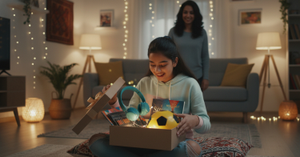It Begins at Home: A Place of Love and Sometimes, Invisible Harm
For most parents, home is a haven, a place where their child should be safest. But sometimes, without realising it, parents or caregivers introduce invisible dangers that quietly affect a child’s health. Secondhand smoke, or passive smoking, is one of them. You might crack a window, step to the balcony, or wait until your child sleeps, but the smoke lingers longer than we think, and the damage runs deeper than it seems.
What Is Passive Smoking?
Passive smoking (or secondhand smoke) is the inhalation of smoke by someone who isn’t actively smoking. It’s a toxic mix of:
- Mainstream smoke (exhaled by a smoker)
- Sidestream smoke (from the lit end of a cigarette, bidi, or cigar)
Even when you can’t see or smell it, the microscopic particles can hang around in furniture, clothes, curtains, walls, and even skin and hair, a phenomenon known as thirdhand smoke.
The Science: How Smoke Harms Children
Children breathe faster than adults and have smaller airways and developing organs, making them extremely vulnerable to environmental toxins.
Key ways passive smoke affects them:
- Lungs and Breathing
A large study in the journal Thorax (PMID: 19996174) showed that children exposed to household smoking had significantly higher rates of lower respiratory illness in the first 5 years of life.
- Ear and Throat Problems Brain Development
In a survey published in Pediatrics (PMID: 23339226), children exposed to secondhand smoke at home scored lower on reading and math tests and had more behavioral concerns in school.
- Immunity
- Sudden Infant Death Syndrome (SIDS)
Real Stories from Real Families
Asha, a mother from Pune, shares:
“My husband always smoked in the kitchen window, thinking the smoke would go out. Our 2-year-old had repeated chest infections. Our pediatrician gently explained how smoke particles linger in clothes and surfaces. When my husband quit, we saw a dramatic improvement.”
Dr. Sameer Kulkarni, a pediatric pulmonologist, explains:
“I often see kids with persistent coughs or asthma whose parents don’t realize the home is the trigger. They say, ‘But I never smoke near the baby!’ That’s where education, not blame, matters most.”
Myths vs. Facts About Passive Smoking
Myth 1: “I smoke in another room, so my child is safe.”
Fact: Smoke travels easily through doors, vents, and fabrics. There is no safe room in the house when smoking happens indoors.
Myth 2: “I smoke at night when the child is asleep.”
Fact: Smoke particles can remain in the air and surfaces for hours—even days—exposing your child when they wake up.
Myth 3: “I smoke near the window or exhaust fan.”
Fact: It might reduce visible smoke, but the harmful chemicals still stay behind.
Myth 4: “I smoke outside, but then I change clothes.”
Fact: Residue on skin, hair, and even breath can still expose infants and young children through thirdhand smoke.
Long-Term Impact of Passive Smoke on Children
- Increased risk of asthma in adolescence
- Greater chances of developing heart disease, diabetes, or cancer later in life
- Mental health challenges, including anxiety and depression, are more common in children exposed to smoke at home
And these effects aren’t just theoretical. They’re backed by decades of research from bodies like the World Health Organization (WHO), Indian Council of Medical Research (ICMR), and Centers for Disease Control and Prevention (CDC).
What Parents Can Do (Without Guilt)
We know change is hard—especially when smoking is a long-standing habit or tied to stress. The goal isn’t guilt. It’s awareness, followed by small steps that make a big difference.
Here’s how you can start protecting your child:
- Make Your Home and Car Smoke-Free Zones: Even one cigarette indoors can expose your child for hours.
- Smoke Outside, and Change Clothes After: If quitting isn’t possible right away, step outside, wear a jacket over your clothes, and wash your hands and face before touching your child.
- Keep Smoking Tools: Out of Sight Don’t normalize tobacco use. Keep lighters, ashtrays, and packs away from children.
- Talk to Your Doctor About Quitting: Support India offers free help through the National Tobacco Quitline (1800-11-2356) and mobile apps like mCessation.
- Involve the Whole Family: Spouses, grandparents, and domestic help should all be on board with keeping the home smoke-free.
- Educate Without Shaming: Share articles or doctor videos with loved ones who smoke. Support, not scolding, creates change.
Final Thoughts: You Don’t Need to Be Perfect, But Just Protective
As parents, we’re constantly learning. Passive smoking isn’t something most of us grew up knowing about, and for many, it’s a blind spot. But now that you know, you have the power to protect. Every smoke-free breath your child takes is a gift. Whether you’re taking the first step or already on the journey to a tobacco-free home, remember: your effort matters. You’re creating a healthier future quietly, lovingly, one decision at a time.








Be the first one to comment on this story.